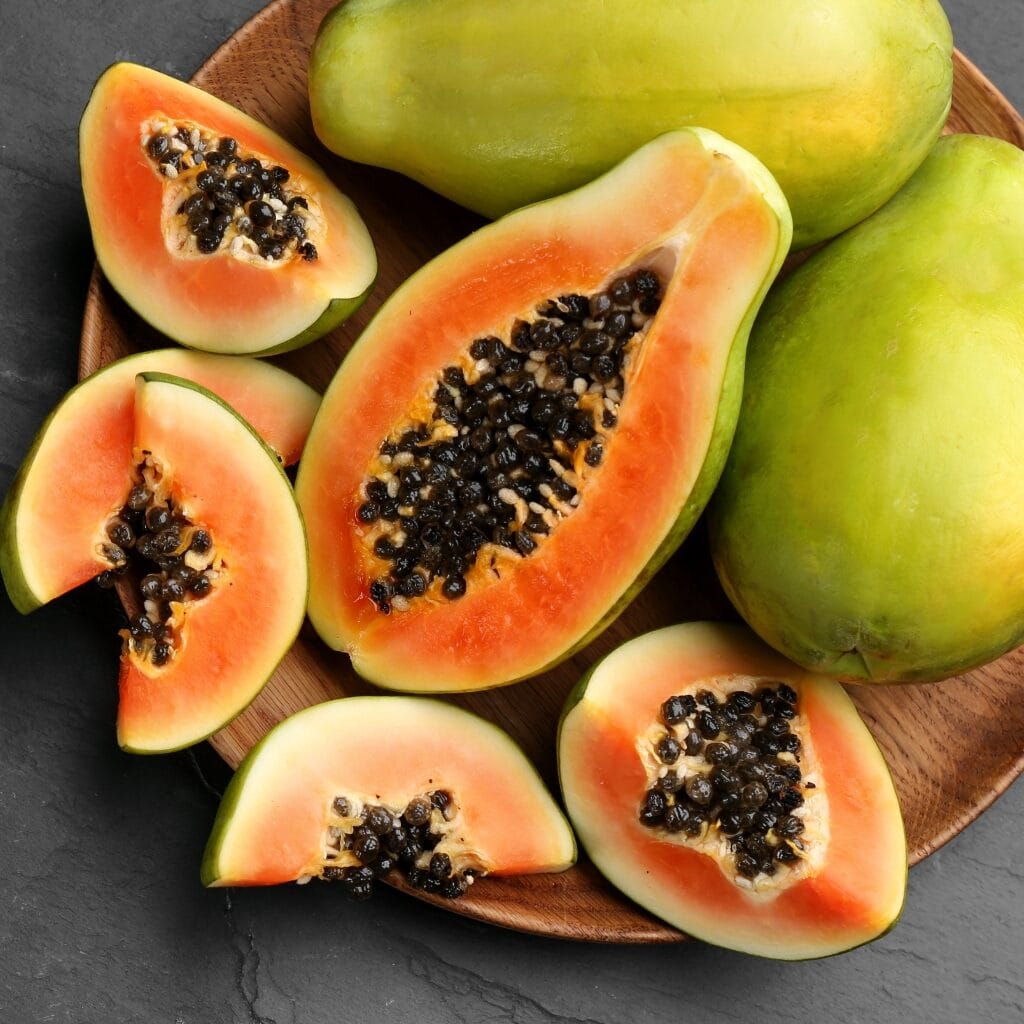What is papaya? It’s the treat that’s been missing from your life!
Papaya is a sweet, juicy fruit with tantalizing flavors that will make your taste buds sing. Native to tropical regions of Central America and Mexico, it’s excellent in smoothies, salads, and more.

This fabulous fruit is packed with an array of nutritional benefits. That makes it, unsurprisingly, a great addition to any diet.
I even have a whole post dedicated to my favorite papaya recipes.
So today, we’ll explore what papaya truly has to offer, including what it is, how it tastes, its health benefits, and more.
Keep scrolling!
What Is Papaya?
(scientific name: Carica papaya)
Papaya is an exotic long, vaguely pear-shaped fruit that’s typically yellow-orange.
They grow in tropical climates and are popular throughout Mexico, Central and South America, and various parts of Asia. They’re also grown regularly in Hawaii.
You’ve probably seen it numerous times in your local grocery store, even if you didn’t know what it was.
When unripe, they’re bright, earthy green. And other varieties may be red or pink.
They have a sweet taste, and even their seeds are edible! (Don’t eat the skin, though!)
Typically, the ones sold commercially weigh between one and three pounds.
They’re also about four to six inches long. However, the fruit can get much larger. (Up to 20 pounds!)
You can eat it raw or cook it. Either way, it’s a delicious tropical treat.

What Does Papaya Taste Like?
Papayas have a sweet, tropical flavor that’s somewhat melon-like. The orange flesh is soft and creamy, and they’re incredibly juicy.
Most people describe them as “refreshing,” which is accurate. They give you that same hydrated feeling as when eating watermelon.
They don’t taste like watermelons, though.
They’re milder, closer to a honeydew melon mixed with some type of exotic, tropical fruit.
Most people who try them really enjoy them.
Health Benefits of Papaya
Besides tasting great, papayas have plenty of additional health benefits.
First and foremost, they’re approximately 88% water.
So if you have difficulty staying hydrated, try adding more papaya to your diet.
Because of their high water content, they also make you feel fuller.
That can aid in weight loss and help manage blood sugar levels. It also improves gut health and aids in digestion.
Papayas are also full of antioxidants and can help boost the immune system.
Here are a few other potential benefits of regular papaya consumption:
- Potentially reduces the risk of certain cancer types and Alzheimer’s
- Increases heart health
- Promotes healthy eyes
- Fights inflammation
Every serving of papaya is also full of things that are good for the body.
For example, you can get 10% of your daily fiber and 106% of your daily vitamin C from papaya!

How to Eat and Cook with Papaya
Unlike many fruits, you can actually eat papaya before it’s ripe.
It’s less sweet this way, but it’s usually okay if you’re cooking with it. If you want to eat it by itself, wait until it fully ripens.
Here are the first few steps for cutting and eating ripe papaya:
- Wash it.
- Slice it lengthwise, cutting it completely in half.
- Separate the halves.
- Remove any visible seeds and trash them. Or set them aside for later use.
At this point, you have a few different options.
You can slice out the flesh of the papaya with a knife and cut it into cubes. You can also use a melon baller.
Finally, you can simply eat it straight from the fruit with a spoon. It’s entirely up to you!
To cook papaya, you follow the same steps listed above.
Then, you can toss it in a blender and puree it. You can also stir-fry it, saute it, bake it, or grill it.
You can even turn it into jams and curries. It’s a very versatile fruit.
As for the seeds, they have a slightly peppery, bitter taste. This makes them an exciting addition to salads.
You can also grind them and use them as you would pepper.
How to Pick a Good Papaya
Picking the right papaya depends first on your needs.
If you want an unripe papaya, look for those with the brightest green skins. They should also be extremely firm.
Knowing how to find a ripe papaya is a little trickier. Are you going to eat the fruit immediately?
If so, look for ones with little to no green left on their skins. They should be softer than green papayas but not too soft.
If you plan to eat it a few days later, selecting one with a bit of green isn’t a bad idea.
That means it still has a few days before it’ll be fully ripe.
Try to avoid papayas that are soft to the touch. Those are likely overripe and will spoil quickly.
If you’ve let one go soft at home, use it to make smoothies instead of eating it raw.

How to Store
If you’ve bought a papaya and are waiting for it to ripen, leave it out.
Putting it in the fridge will slow down the ripening process. Instead, leave it somewhere in your kitchen to ripen.
You can also place it in a brown paper bag to speed up the process.
If you have leftovers or a fully ripe fruit to store, that’s another story. Those should go into the refrigerator.
Wrap whole, uncut fruits in a plastic bag first.
Put leftovers or cut papayas into an airtight container.
You can also freeze leftover papaya, but the process is different. Follow these steps to properly freeze your papaya:
- Cut them into smaller, snack-size pieces.
- Place the pieces into freezer-safe airtight containers or Ziploc bags.
- In a separate container, combine four cups of water and two cups of sugar.
- Pour this sugar water solution over the papaya pieces in their container. (Doing so will help preserve the fruit.)
- Store it in the freezer for up to 10 months.
Once frozen, thawed papaya works best for smoothies or cooking.
If you want to eat it raw, do so after it’s only partially thawed.
Fully thawed papaya is sometimes too mushy.











